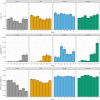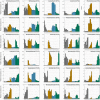Rapid Formation of Microbe-Oil Aggregates and Changes in Community Composition in Coastal Surface Water Following Exposure to Oil and the Dispersant Corexit
- PMID: 29696005
- PMCID: PMC5904270
- DOI: 10.3389/fmicb.2018.00689
Rapid Formation of Microbe-Oil Aggregates and Changes in Community Composition in Coastal Surface Water Following Exposure to Oil and the Dispersant Corexit
Abstract
During the Deepwater Horizon (DWH) oil spill, massive quantities of oil were deposited on the seafloor via a large-scale marine oil-snow sedimentation and flocculent accumulation (MOSSFA) event. The role of chemical dispersants (e.g., Corexit) applied during the DWH oil spill clean-up in helping or hindering the formation of this MOSSFA event are not well-understood. Here, we present the first experiment related to the DWH oil spill to specifically investigate the relationship between microbial community structure, oil and Corexit®, and marine oil-snow in coastal surface waters. We observed the formation of micron-scale aggregates of microbial cells around droplets of oil and dispersant and found that their rate of formation was directly related to the concentration of oil within the water column. These micro-aggregates are potentially important precursors to the formation of larger marine oil-snow particles. Therefore, our observation that Corexit® significantly enhanced their formation suggests dispersant application may play a role in the development of MOSSFA events. We also observed that microbial communities in marine surface waters respond to oil and oil plus Corexit® differently and much more rapidly than previously measured, with major shifts in community composition occurring within only a few hours of experiment initiation. In the oil-amended treatments without Corexit®, this manifested as an increase in community diversity due to the outgrowth of several putative aliphatic- and aromatic-hydrocarbon degrading genera, including phytoplankton-associated taxa. In contrast, microbial community diversity was reduced in mesocosms containing chemically dispersed oil. Importantly, different consortia of hydrocarbon degrading bacteria responded to oil and chemically dispersed oil, indicating that functional redundancy in the pre-spill community likely results in hydrocarbon consumption in both undispersed and dispersed oils, but by different bacterial taxa. Taken together, these data improve our understanding of how dispersants influence the degradation and transport of oil in marine surface waters following an oil spill and provide valuable insight into the early response of complex microbial communities to oil exposure.
Keywords: MOSSFA; deepwater horizon; marine oil-snow; micro-aggregate; oil and corexit®.
Figures







Similar articles
-
How the dispersant Corexit impacts the formation of sinking marine oil snow.Mar Pollut Bull. 2017 Dec 15;125(1-2):139-145. doi: 10.1016/j.marpolbul.2017.08.015. Epub 2017 Aug 12. Mar Pollut Bull. 2017. PMID: 28807420
-
The Interactive Effects of Crude Oil and Corexit 9500 on Their Biodegradation in Arctic Seawater.Appl Environ Microbiol. 2020 Oct 15;86(21):e01194-20. doi: 10.1128/AEM.01194-20. Print 2020 Oct 15. Appl Environ Microbiol. 2020. PMID: 32826215 Free PMC article.
-
The interplay of extracellular polymeric substances and oil/Corexit to affect the petroleum incorporation into sinking marine oil snow in four mesocosms.Sci Total Environ. 2019 Nov 25;693:133626. doi: 10.1016/j.scitotenv.2019.133626. Epub 2019 Jul 26. Sci Total Environ. 2019. PMID: 31377363
-
Was the extreme and wide-spread marine oil-snow sedimentation and flocculent accumulation (MOSSFA) event during the Deepwater Horizon blow-out unique?Mar Pollut Bull. 2015 Nov 15;100(1):5-12. doi: 10.1016/j.marpolbul.2015.08.023. Epub 2015 Sep 8. Mar Pollut Bull. 2015. PMID: 26359115 Review.
-
A critical review of marine snow in the context of oil spills and oil spill dispersant treatment with focus on the Deepwater Horizon oil spill.Mar Pollut Bull. 2018 Oct;135:346-356. doi: 10.1016/j.marpolbul.2018.07.028. Epub 2018 Jul 18. Mar Pollut Bull. 2018. PMID: 30301046 Review.
Cited by
-
Bacterial abundance and diversity in 64-74 Ma subseafloor igneous basement from the Louisville Seamount Chain.mLife. 2024 Dec 24;3(4):578-583. doi: 10.1002/mlf2.12148. eCollection 2024 Dec. mLife. 2024. PMID: 39744091 Free PMC article.
-
Niche Partitioning between Coastal and Offshore Shelf Waters Results in Differential Expression of Alkane and Polycyclic Aromatic Hydrocarbon Catabolic Pathways.mSystems. 2020 Aug 25;5(4):e00668-20. doi: 10.1128/mSystems.00668-20. mSystems. 2020. PMID: 32843540 Free PMC article.
-
A Review on Biotechnological Approaches Applied for Marine Hydrocarbon Spills Remediation.Microorganisms. 2022 Jun 25;10(7):1289. doi: 10.3390/microorganisms10071289. Microorganisms. 2022. PMID: 35889007 Free PMC article. Review.
-
Changes in the Bacterioplankton Community Structure from Southern Gulf of Mexico During a Simulated Crude Oil Spill at Mesocosm Scale.Microorganisms. 2019 Oct 11;7(10):441. doi: 10.3390/microorganisms7100441. Microorganisms. 2019. PMID: 31614583 Free PMC article.
-
Bacteria-Oil Microaggregates Are an Important Mechanism for Hydrocarbon Degradation in the Marine Water Column.mSystems. 2021 Oct 26;6(5):e0110521. doi: 10.1128/mSystems.01105-21. Epub 2021 Oct 5. mSystems. 2021. PMID: 34609162 Free PMC article.
References
-
- Alonso-Gutiérrez J., Figueras A., Albaiges J., Jimenez N., Vinas M., Solanas A. M., et al. (2009). Bacterial communities from shoreline environments (costa da morte, northwestern spain) affected by the prestige oil spill. Appl. Environ. Microbiol. 75, 3407–3418. 10.1128/AEM.01776-08 - DOI - PMC - PubMed
-
- Apprill A., McNally S., Parsons R., Weber L. (2015). Minor revision to V4 region SSU rRNA 806R gene primer greatly increases detection of SAR11 bacterioplankton. Aquat. Microb. Ecol. 75, 129–137. 10.3354/ame01753 - DOI
LinkOut - more resources
Full Text Sources
Other Literature Sources

